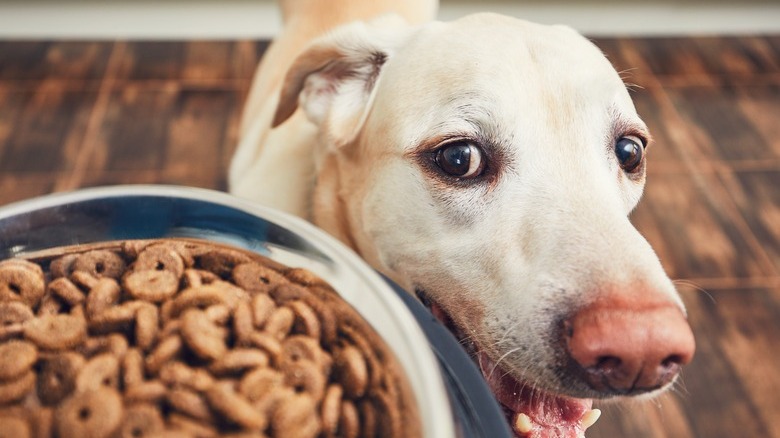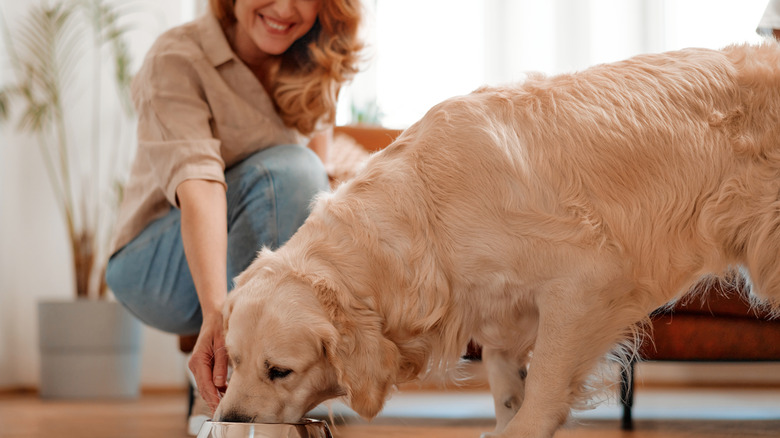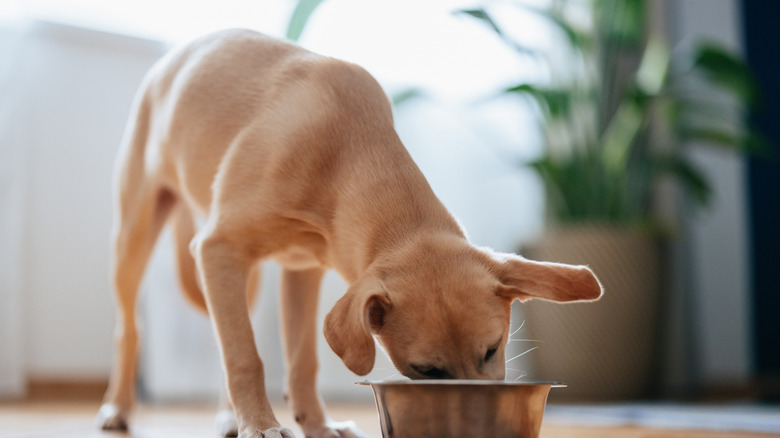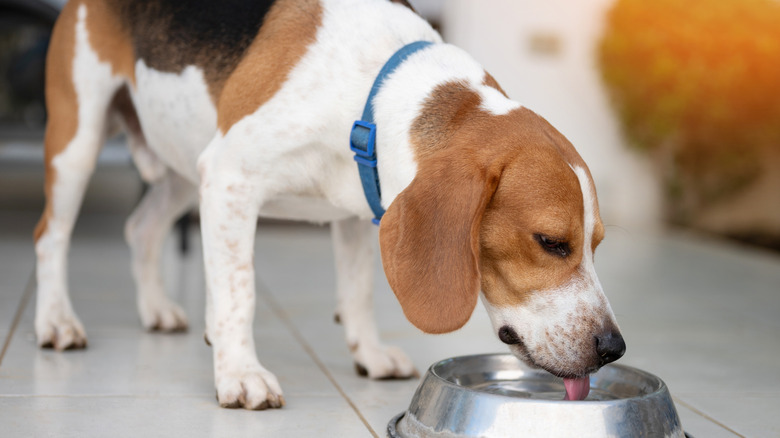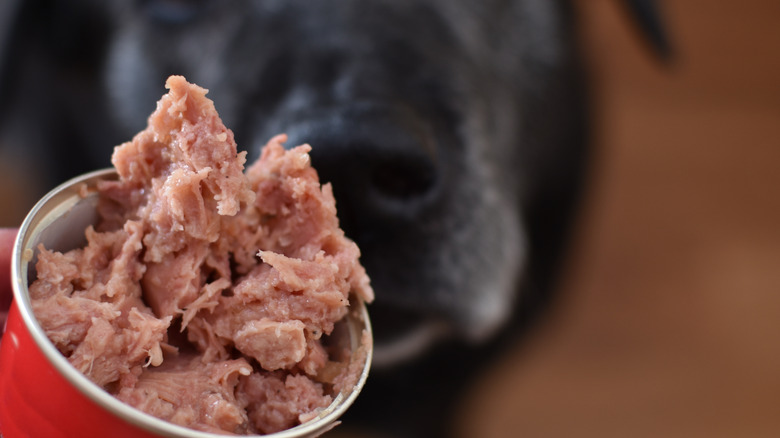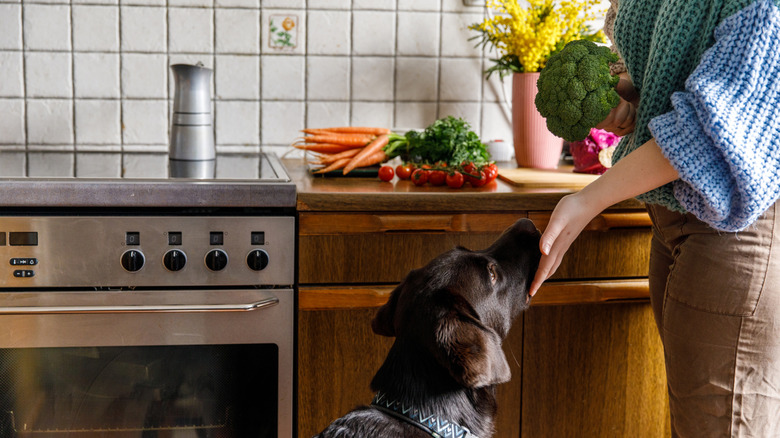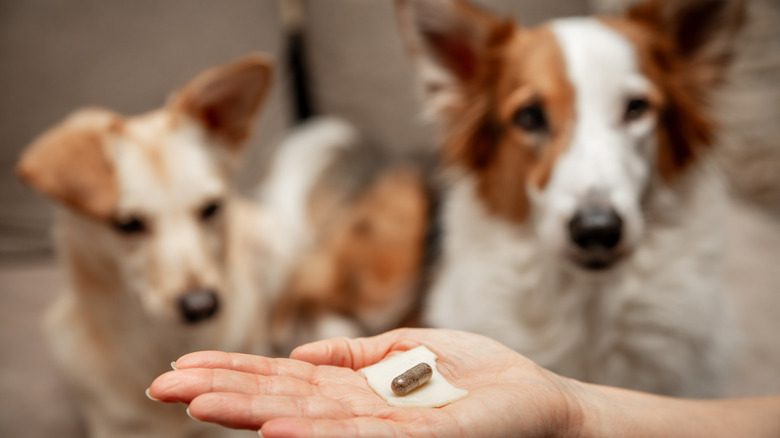Safe Foods For Dogs With Chronic Kidney Failure
We may receive a commission on purchases made from links.
Cuteness may earn compensation through affiliate links in this article.
Your dog is lapping up water from his bowl in ever-increasing amounts, and then scratching at the backdoor to go out much more often than usual. At the same time, he's not scrambling to his food dish and agitating for dinner like he used to.
Increased thirst coinciding with increased urine production, as well as a decrease in appetite, may be signs of kidney disease. This can be hard to detect by pet owners initially. By the time your dog exhibits symptoms of kidney failure, the kidneys may only be functioning at one-quarter to one-third of normal levels. As the damage to the organ progresses, increased blood flow moves towards the kidneys in an attempt to filter waste products. This causes dogs to experience increased thirst and even dehydration. While dogs with kidney disease can't be cured, their lives can be prolonged by carefully managing their diet.
Why good nutrition is important for dogs with kidney problems
Nutrition is a primary component in managing your dog's kidney failure. Overall, dogs with kidney disease require less protein, phosphorous, and sodium, but should increase their intake of omega-3 fatty acids.
This diet will help reduce the toxins that the kidneys normally flush out, as well as minimize issues with fluid and mineral balance. While a dog kidney failure diet can't reverse the damage already done or cure your pet, it can both prolong her life and help her feel better. Feeding three to four small meals a day rather than one or two larger ones can help spread out the amount of waste material kidneys filter throughout the day.
An important component of treating chronic kidney failure is ensuring adequate hydration. Dogs with kidney disease should be given an unlimited supply of water. Feeding them canned wet food rather than dry can also help increase their fluid intake.
Low-protein diets
Some research has shown that decreasing the amount of protein in your dog's food could help lower the work the kidneys must do to break down waste products. As protein is broken down, waste products related to nitrogen are released. These include urea, uric acid, creatinine, and hippuric acid, with urea being the most common. Less need for filtration helps preserve kidney function.
However, according to Pet MD, whether or not your dog will benefit from eating less protein depends on what stage your dog's kidney disease is. Dogs who have had the disease for longer are more likely to benefit from this diet than a dog whose kidney disease is still new.
If you wish to provide your dog with a low-protein diet, look for foods that are 14 to 20 percent protein by dry weight. Dogs without special dietary restrictions need food that is 18 to 25 percent protein.
Low phosphorous and low sodium foods for dogs
While vets don't know the exact reason, lowering the amount of phosphorous in the diet can also slow the progression of kidney disease. The amount of protein in food is linked with the amount of phosphorous so that when protein is lowered in the diet, so is phosphorous.
Bones, egg yolks, dairy products, and organ meats have high phosphorous content, and while your dog can consume these, the amount should be limited. Dogs with chronic kidney failure should eat food that is between 0.2 to 0.5 percent phosphorous. They should consume no more than 7 to 18 mg of phosphorus per pound of weight each day to maintain a low phosphorous diet.
Some vets also recommend lowering sodium levels since 60% or more of dogs with kidney failure also have high blood pressure. High blood pressure can further decrease kidney function.
Increase fat and fatty acids
Most dogs with chronic kidney failure will lose weight as the disease progresses and their appetites decrease. That means feeding your dog high-calorie, nutrient-dense food can help them maintain weight.
One way to do this is to gradually increase the amount of fat in your dog's diet. Little phosphorous is found in fats. Fatty meats like lamb and pork are one choice, as are whole milk products. A little bacon fat may revive your dog's interest in food and add extra calories.
The omega-3 fatty acids in fish oil may slow the progression of kidney disease, and supplements can be a helpful addition to dogs with a kidney disease diet. Liquid fish oil capsules can be given. The EPA (eicosapentaenoic acid) and DHA (docosahexaenoic acid) in fish oil can help reduce inflammation as well as creatinine while reducing pressure on the kidneys.
Homemade food for dogs with kidney disease
One way to control what ingredients your dog ingests is to make their food yourself. One sample diet for a 40-pound dog calls for 6 ounces of meat (such as chicken or beef), 6 ounces of grains and vegetables (like potatoes and beets), one large egg plus an egg white, and an ounce of liver or kidney meat per day, divided into two meals. A teaspoon of ground eggshell can be added to each meal to add calcium and bind phosphorous. Fish oil can be added as long as its not cod liver oil.
One recipe for chicken and potato dog food that is low in protein, phosphorous, and sodium, but high in potassium calls for 1/4 cooked chicken breast, 3 cups of potatoes boiled in the skin, 2 tablespoons of chicken fat, 1 1/2 calcium carbonate tablets, and 1/2 multiple vitamin and 1/2 mineral tablet. The recipe is appropriate for a 21- to 22-pound dog and provides 689 calories, 18.9 g protein, 26.8 g fat, as well as 45 percent of phosphorus, 54 percent of sodium, and 301 percent of potassium daily requirement for a healthy dog.
Supplements for dogs with kidney failure
Before you purchase any products for dogs that are experiencing kidney failure, clear them with your veterinarian. As long as they give you the go ahead, you can try Nordic Naturals Omega-3 Pet Soft Gels. Each serving provides your dog with 330mg of omega-3 fatty acids, which contributes glossy, silky coat, and it help you manage normal shedding.
Another option is Pet Wellbeing's Kidney Support Gold for Dogs, liquid drops that will promote a natural increase in energy levels as well as general vitality. It will also moderate normal hydration and help a dog maintain a healthy weight and regular appetite. It's prepared from organically grown and selectively imported herbs from trusted growers, too.
